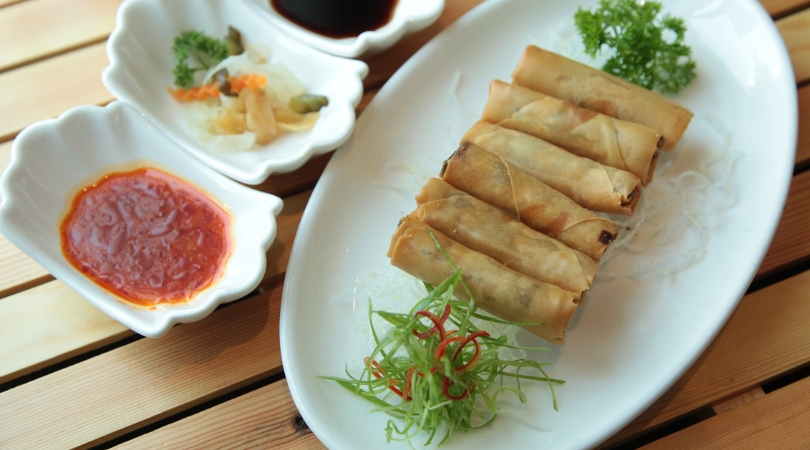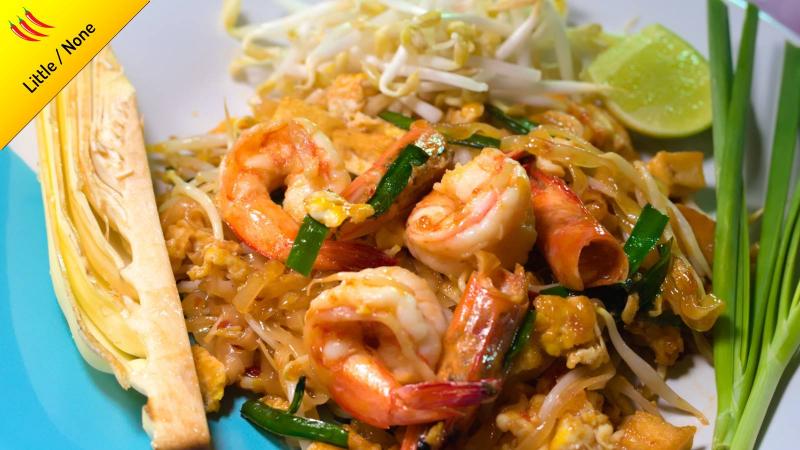Introduction

Thai cuisine has gained immense popularity around the world, known for its vibrant flavors and unique blend of spices. However, there is a common misconception that all Thai food is spicy. In this article, we will debunk this spice myth and explore the different levels of spiciness found in Thai dishes. By understanding the spice scale and the factors that contribute to spiciness, you can confidently navigate through mild, medium-spiced, and spicy Thai dishes. So, let’s delve into the world of Thai cuisine and discover the truth behind its spice levels.
The Popularity Of Thai Cuisine
The popularity of Thai cuisine has soared across the globe, captivating palates with its unique flavors and aromatic spices. Thai restaurants can be found in almost every major city, and people from all walks of life have developed a fondness for this vibrant cuisine. From classic dishes like Pad Thai and Green Curry to lesser-known delicacies, Thai food offers a diverse range of flavors that appeal to a wide audience. Its popularity can be attributed to the perfect balance of sweet, sour, salty, and umami flavors, creating an exciting culinary experience for all who indulge.
Exploring The Thai Spice Factor
Exploring the Thai spice factor:
Thai cuisine is often associated with spiciness, but it’s important to understand that not all Thai dishes are inherently spicy. The level of spice in Thai food can vary greatly, depending on personal preferences and regional influences. Thai cuisine offers a wide range of flavors, from mild and balanced to fiery and intense. The use of herbs, spices, and chili peppers contributes to the distinct spice factor in Thai dishes. However, it’s worth noting that spiciness can be adjusted or customized according to individual taste preferences. So, whether you prefer mild, medium, or spicy, Thai cuisine has something for everyone.
The Spice Levels In Thai Food

Thai food offers a diverse range of spice levels to cater to different tastes and preferences. The spiciness in Thai cuisine can vary from mild to medium to hot, allowing individuals to choose dishes that suit their tolerance for heat. It is important to note that not all Thai dishes are inherently spicy. The spice factor can be adjusted according to personal preference. Whether you enjoy the mild flavors of dishes like Pad Thai or prefer the fiery kick of dishes like Tom Yum Soup, Thai cuisine has options for everyone’s spice tolerance.
Understanding The Spiciness Scale In Thai Cuisine
Thai cuisine follows a spiciness scale that ranges from mild to hot. This scale helps individuals gauge the level of heat in different dishes. The spiciness is typically categorized into three levels: mild, medium, and hot. It is important to note that the actual scale may vary depending on the region or individual preferences. Thai dishes are often labeled with symbols or numbers to indicate their spiciness level, allowing diners to make informed choices. Understanding this scale is essential for those who prefer milder flavors or are looking to challenge their taste buds with fiery dishes.
Factors That Contribute To Spiciness
There are several factors that contribute to the spiciness of Thai food. One of the main factors is the use of chili peppers, which are a staple ingredient in Thai cuisine. Different types of chili peppers, such as bird’s eye chili or Thai chili, can vary in their level of heat. Additionally, the intensity of spiciness can be influenced by the amount of chili peppers used in a dish. Other ingredients like ginger, garlic, and spices can also contribute to the overall spiciness. The cooking method and the balance of flavors in the dish can further enhance or tone down the spice level.
Mild Thai Dishes

Popular mild Thai dishes offer a flavorful and satisfying culinary experience without overwhelming spiciness. Some popular examples include Pad Thai, a stir-fried noodle dish with a balanced combination of sweet and savory flavors, and Tom Kha Gai, a coconut milk-based soup with chicken and aromatic herbs. These dishes typically feature milder types of chili peppers or use them sparingly. For those who prefer a milder taste, opting for these dishes can provide a delightful introduction to Thai cuisine. To further enhance the mildness, you can request the dish to be prepared with less chili or spice.
Popular Mild Thai Dishes
Some popular mild Thai dishes include Pad Thai and Tom Kha Gai. Pad Thai is a classic stir-fried noodle dish that offers a balanced combination of sweet and savory flavors. It typically does not contain overwhelming spiciness. Tom Kha Gai is a coconut milk-based soup with chicken and aromatic herbs. It has a creamy and slightly tangy taste without being overly spicy. These dishes often feature milder types of chili peppers or use them sparingly, making them a great choice for those who prefer a milder taste. To enhance the mildness, you can request less chili or spice when ordering.
Tips For Enjoying Milder Options
When it comes to enjoying milder options in Thai cuisine, there are a few tips to keep in mind.
- Communicate your spice preference: Don’t hesitate to let the server know that you prefer milder dishes. They can guide you towards options that are not too spicy.
- Request less spice: You can ask for your dish to be prepared with less chili or spice to make it milder. Most restaurants are happy to accommodate your preferences.
- Balance flavors: Look for dishes that offer a balance of flavors like sweet, sour, and savory. These dishes tend to be milder in spice while still being delicious.
- Explore different dishes: Thai cuisine offers a wide range of dishes that are not inherently spicy. Try dishes like Pad Thai, Tom Kha Gai, and Green Curry without worrying about overwhelming spice levels.
Remember, enjoying milder options doesn’t mean compromising on taste. There are plenty of delicious Thai dishes that cater to different spice preferences.
Medium-spiced Thai Dishes

Medium-spiced Thai dishes offer a balance of flavors and a moderate level of spiciness. Some popular medium-spiced dishes include Pad Kra Pao (stir-fried meat with chili and basil), Pad See Ew (stir-fried rice noodles with soy sauce and vegetables), and Yellow Curry. These dishes typically have a hint of spice without being overwhelmingly hot. To navigate medium-spiced dishes, consider adding a squeeze of lime or a dollop of coconut milk to help mellow the heat. It’s important to communicate your spice preference to the server, as they can adjust the spiciness level to suit your taste.
Popular Medium-spiced Thai Dishes
Some popular medium-spiced Thai dishes include Pad Kra Pao (stir-fried meat with chili and basil), Pad See Ew (stir-fried rice noodles with soy sauce and vegetables), and Yellow Curry. These dishes offer a balanced blend of flavors and a moderate level of spiciness. They provide just the right amount of heat without overwhelming your taste buds. To enhance the flavors and mellow the spiciness, consider adding a squeeze of lime or a dollop of coconut milk. Remember to communicate your spice preference to the server, as they can adjust the spiciness level to suit your taste.
Tips For Navigating Medium-spiced Dishes
When it comes to navigating medium-spiced Thai dishes, there are a few tips that can enhance your dining experience. Here are some suggestions to keep in mind:
- Communicate your spice preference: Let the server know that you prefer a medium level of spiciness. This way, they can adjust the dish to suit your taste.
- Gradually increase the heat: If you’re new to medium-spiced dishes, start by exploring milder options and gradually work your way up. This will allow your palate to adjust to the flavors and spiciness.
- Use condiments strategically: Experiment with condiments like lime wedges, coconut milk, or additional herbs to mellow the spiciness and elevate the flavors of the dish.
- Enjoy with rice or noodles: Pairing medium-spiced dishes with rice or noodles can help balance out the heat and provide a satisfying meal.
- Take breaks: If the spiciness becomes overwhelming, don’t hesitate to take short breaks and sip on water or eat something mild to cool your palate.
By following these tips, you can navigate medium-spiced Thai dishes and fully enjoy the flavors without feeling overwhelmed by the spice.
Spicy Thai Dishes

Spicy Thai dishes are known for their fiery flavors that pack a punch. Some popular examples include Tom Yum Soup, Green Curry, and Pad Thai with added chili flakes. These dishes are characterized by the use of hot chili peppers, such as Thai bird’s eye chili, which add heat and depth to the flavors. When enjoying spicy Thai dishes, it’s important to be prepared for the intense spiciness. It’s recommended to start with smaller portions or request a milder version if you have a lower tolerance for spice.
Popular Spicy Thai Dishes
Popular spicy Thai dishes are known for their intense heat and bold flavors. Some of the most popular spicy Thai dishes include:
- Tom Yum Soup: This fragrant and spicy soup is made with a spicy broth, shrimp or chicken, lemongrass, lime leaves, and chili peppers. It offers a perfect balance of spicy, sour, and savory flavors.
- Green Curry: A staple in Thai cuisine, green curry is made with a paste of green chilies, garlic, lemongrass, and other aromatic herbs. It can be made with different proteins, such as chicken, beef, or tofu, and is typically served with steamed rice.
- Pad Kra Pao: This stir-fried dish features minced meat (usually pork or chicken), holy basil, garlic, chili peppers, and soy sauce. It is commonly served over steamed rice with a fried egg on top.
- Spicy Papaya Salad (Som Tam): This refreshing salad is made with shredded green papaya, tomatoes, chili peppers, lime juice, fish sauce, and peanuts. It is a perfect balance of spicy, sour, and sweet flavors.
- Spicy Basil Chicken (Pad Krapow Gai): This dish is made with stir-fried chicken, Thai chili peppers, garlic, and holy basil. It is often served with steamed rice and a fried egg.
These dishes offer a fiery kick and are perfect for those who love spicy food. Remember to adjust the spice level according to your taste preferences by requesting milder versions or adding more chili peppers for extra heat.
Tips For Handling The Heat
When it comes to handling the heat in spicy Thai dishes, there are a few tips that can help you enjoy the flavors without overwhelming your taste buds:
- Start with milder dishes: If you’re new to spicy food, begin with milder Thai dishes and gradually work your way up to spicier options.
- Balance the heat: Use non-spicy ingredients like coconut milk, lime juice, or sugar to help balance out the spiciness in your dish.
- Drink something cooling: Have a glass of milk or eat a spoonful of yogurt to soothe the heat in your mouth.
- Take small bites: Pace yourself and take small bites to allow your taste buds to adjust to the spiciness.
- Watch out for the seeds: The seeds in chili peppers are the hottest part, so remove them if you prefer a milder experience.
Remember, everyone’s tolerance for spice is different, so adjust the spice level according to your own preferences.
Debunking The Spice Myth

Debunking the Spice Myth: Some people have the misconception that all Thai food is spicy. However, the truth is that not all Thai dishes are fiery hot. Thai cuisine offers a range of flavors, from mild to spicy, catering to different taste preferences. While some dishes may have a kick of heat, there are plenty of options for those who prefer milder flavors. It’s important to understand that Thai food is about balancing flavors, and spice is just one element. So don’t let the spice myth deter you from exploring the rich and diverse world of Thai cuisine.
Addressing Misconceptions About Thai Food Spiciness
Thai food is often associated with intense spiciness, but this is a misconception that needs to be addressed. While it is true that some Thai dishes can be very spicy, not all Thai food falls into this category. Thai cuisine offers a wide range of flavors, from mild to spicy, allowing individuals to adjust the level of heat according to their preferences. It’s important to remember that spice is just one element of Thai cuisine, and it is possible to enjoy the diverse and delicious flavors of Thai food without feeling overpowered by heat. So don’t let the misconception of Thai food being overly spicy deter you from exploring this incredible cuisine.
Final Thoughts And Recommendations
In conclusion, it is important to debunk the myth that all Thai food is spicy. While Thai cuisine does offer dishes with varying levels of heat, it is not a requirement to always opt for spicy options. Thai food is known for its complex flavors and diverse range of dishes, allowing individuals to enjoy mild, medium-spiced, or spicy options based on personal preference. It’s important to explore and experiment with different Thai dishes to discover the flavors that you enjoy the most. Whether it’s a mild Pad Thai or a spicy Green Curry, Thai cuisine has something for everyone. So, don’t let the misconception of Thai food spiciness deter you from indulging in this delicious and vibrant cuisine.
Frequently Asked Questions About Thai Food Spice Levels
Thai cuisine is renowned for its vibrant flavors, which often include a delightful kick of spice. Here are some frequently asked questions about the spiciness of Thai food, answered for your convenience:
Q: Is all Thai food spicy?
A: No, not all Thai food is spicy. While many Thai dishes do incorporate chili peppers and spices, the level of spiciness can vary greatly. There are plenty of non-spicy Thai dishes that are equally delicious and enjoyable.
Q: What makes Thai food spicy?
A: The spiciness in Thai food usually comes from chili peppers, such as bird’s eye chili or Thai chili. These peppers are small but pack a punch in terms of heat. Different chili varieties are used in various Thai dishes, and they can be added in the form of paste, powder, or whole peppers.
Q: How do Thai people determine spice levels in their food?
A: Thai people often use a scale called the “scoville scale” to measure the heat of chili peppers. This scale rates peppers based on their capsaicin content, the compound responsible for the spicy sensation. The higher the rating, the spicier the pepper, and consequently, the dish it is used in.
Q: I can’t handle a lot of spice. Can I still enjoy Thai food?
A: Absolutely! Thai cuisine offers a wide variety of dishes with different spice levels to suit every palate. If you prefer milder flavors, you can simply ask for less or no chili when ordering. Many Thai restaurants are accustomed to adjusting spice levels based on individual preferences, so don’t hesitate to communicate your desired level of heat.
Q: What are some non-spicy Thai dishes?
A: There are numerous non-spicy Thai dishes that are still incredibly flavorsome. Some popular examples include Pad Thai (stir-fried noodles), Green Curry with Chicken, Thai Fried Rice (Khao Pad), Tom Kha Gai (coconut milk soup with chicken), and Mango Sticky Rice (a delicious dessert). These options provide a wonderful introduction to Thai cuisine without overwhelming heat.
Q: How can I build my tolerance for spice in Thai food?
A: If you’re interested in developing a tolerance for spice, start by gradually incorporating spicier dishes into your diet. Begin with milder options and work your way up over time. Additionally, having rice or a spoonful of plain yogurt nearby can help to alleviate the heat if it becomes too intense.
Q: Are there regional differences in spiciness levels in Thai cuisine?
A: Yes, there are regional differences in the spiciness levels of Thai cuisine. The cuisine of northern Thailand, for example, tends to be spicier overall compared to the milder flavors found in southern Thai dishes. It’s always a good idea to inquire about the spice levels when trying a new dish from a specific region.
Remember, the level of spiciness in Thai food is highly customizable, allowing you to enjoy the cuisine regardless of your preference for heat. Don’t shy away from trying new dishes, and feel free to communicate your spice preferences to ensure an enjoyable dining experience.

We are a small takeaway restaurant offering a great selection of food cooked by our Thai chef. Table spaces are limited, so please book in advance.